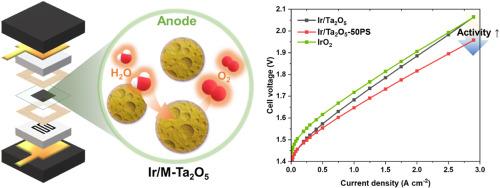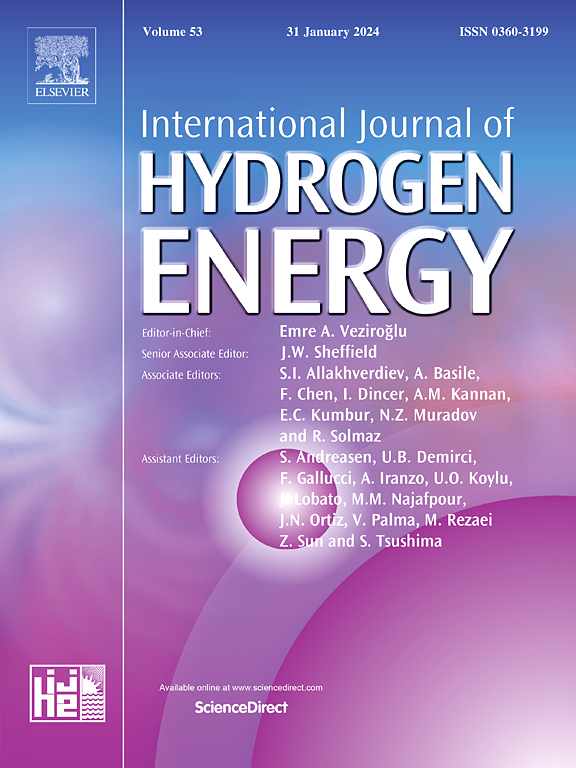多孔氧化钽载体上的先进铱催化剂用于高效质子交换膜电解
IF 8.1
2区 工程技术
Q1 CHEMISTRY, PHYSICAL
引用次数: 0
摘要
如何在保持膜电极组件(MEA)性能的同时减少Ir和Pt等贵金属的负载,是开发高效质子交换膜水电解槽(PEMWEs)面临的重大挑战。本研究提出了一种高活性和经济高效的催化剂,由铱支撑在多孔氧化钽(M - Ta₂O₅)上,它集成了大孔和介孔。在M−Ta2O5上负载的铱纳米结构提高了Ir的利用率,并表现出更大的电化学表面积。Ir负载为30 wt%时,Ir/M - Ta₂O₅催化剂在电流密度为10 mA cm⁻2时的过电位为290.4±3.5 mV,在1.55 VRHE时的质量活度为7305±44.6 a gIr⁻1。因此,Ir/M - Ta2O5可以有效地用于制备Ir负载为0.2 mg cm - 2的MEA和Nafion®115膜。在单电池水平上,该催化剂在1.89 V下达到2.5 a cm⁻2的电流密度,强调了Ir/M−Ta2O5作为高效且经济实惠的OER催化剂的潜力。这项工作突出了Ir/M - Ta₂O₅在减少对贵金属的依赖方面的承诺,从而有助于PEMWEs的经济和环境可持续性。本文章由计算机程序翻译,如有差异,请以英文原文为准。

Advanced iridium catalysts on multi-porous tantalum oxide supports for efficient proton exchange membrane water electrolysis
Reducing the loading of precious metals such as Ir and Pt while maintaining the performance of membrane electrode assembly (MEA) with highly active oxygen evolution reaction (OER) catalysts is a significant challenge in the development of efficient proton exchange membrane water electrolyzers (PEMWEs). This study presents a highly active and cost-effective catalyst consisting of iridium supported on multi-porous tantalum oxide (M−Ta₂O₅), which integrates both macropores and mesopores. The iridium nanostructures supported on the M−Ta2O5 enhance the utilization of Ir and exhibit larger electrochemical surface areas. With a 30 wt% Ir loading, the Ir/M−Ta₂O₅ catalyst demonstrates an overpotential of 290.4 ± 3.5 mV at a current density of 10 mA cm⁻2 and a mass activity of 730.5 ± 44.6 A gIr⁻1 at 1.55 VRHE. Consequently, Ir/M−Ta2O5 can be effectively utilized to fabricate MEA with an Ir loading of 0.2 mg cm−2 and Nafion® 115 membrane. At the single-cell level, this catalyst achieves a current density of 2.5 A cm⁻2 at 1.89 V, underscoring the potential of Ir/M−Ta2O5 as a highly efficient and cost-affordable OER catalyst. This work highlights the promise of Ir/M−Ta₂O₅ in reducing the reliance on precious metals, thereby contributing to the economic and environmental sustainability of PEMWEs.
求助全文
通过发布文献求助,成功后即可免费获取论文全文。
去求助
来源期刊

International Journal of Hydrogen Energy
工程技术-环境科学
CiteScore
13.50
自引率
25.00%
发文量
3502
审稿时长
60 days
期刊介绍:
The objective of the International Journal of Hydrogen Energy is to facilitate the exchange of new ideas, technological advancements, and research findings in the field of Hydrogen Energy among scientists and engineers worldwide. This journal showcases original research, both analytical and experimental, covering various aspects of Hydrogen Energy. These include production, storage, transmission, utilization, enabling technologies, environmental impact, economic considerations, and global perspectives on hydrogen and its carriers such as NH3, CH4, alcohols, etc.
The utilization aspect encompasses various methods such as thermochemical (combustion), photochemical, electrochemical (fuel cells), and nuclear conversion of hydrogen, hydrogen isotopes, and hydrogen carriers into thermal, mechanical, and electrical energies. The applications of these energies can be found in transportation (including aerospace), industrial, commercial, and residential sectors.
 求助内容:
求助内容: 应助结果提醒方式:
应助结果提醒方式:


